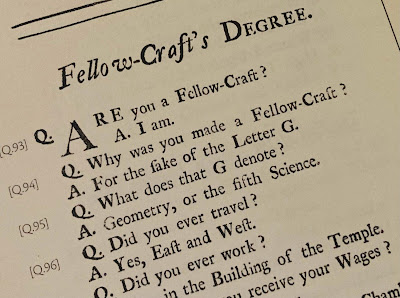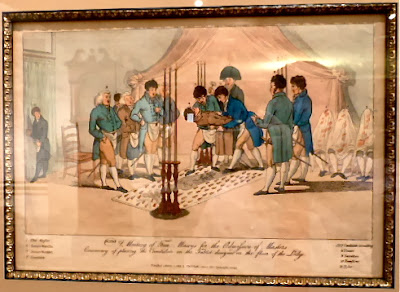Sunday, October 27, 2024
‘1764 MM° in November’
Thursday, September 29, 2022
‘1730 Fellow-Craft’s Degree’
Thank you for reading The Magpie Mason. Today, we begin our fifteenth year together.
Publicity Lodge 1000 returned from its Summer Refreshment on Monday the twelfth, beginning a new year of Masonic labor. The Magpie Mason was scheduled to present a discussion of Masonic educational value, so, with a Ceremony of Passing on the trestleboard for an upcoming meeting, I chose the Fellow Craft Degree as that topic of conversation. And not just any second degree, but the one printed in 1730 by one Samuel Prichard in his essential ritual exposure Masonry Dissected, newly published by the Masonic Book Club. Masonic rituals, Masonic lodges, Masonic grand lodges, Masonic everythings were very different 300 years ago. All of it was very basic compared to what we have today.
I explained how when Masons think of lodges, we understandably envision the modern lodge room, with its varied furniture, seating arrangement, equipment, décor, etc., but things were primitive in the early eighteenth century when lodges met in tavern dining rooms or in private homes. There were no tall pillars flanking the Inner Door (there was no Inner Door!), and instead the brethren spoke ritually of J and B, explaining their purposes and describing their looks, using language similar enough to what we know today.
I told the lodge I was going to read the ritual of the degree. Read the ritual?! That could take hours! Yet the ritual of that period was very basic as well, consisting of a call-and-response dialog among the Worshipful Master and the brethren (not unlike our current Opening and Closing rituals) that spans only five pages of the MBC edition. The Fellow Craft Degree of 1730 included no elaborate floor work, no lengthy monolog lecture or other ceremonious orations, no hoodwink, nor other elements we today expect. Some of those features already were revealed to the candidate during the “Enter’d ’Prentice’s Degree,” and so went forsaken in the second degree. Anyway, reading the entire “Fellow-Craft’s Degree” ritual required only a couple of minutes. I won’t transcribe it all here, but do recommend to you the new book from the MBC. They will have more copies for sale after the subscription sales have been satisfied. (I saw Lewis Masonic had it listed for sale the other day, but it seems to be gone from their website now.)
Unsurprisingly, the letter G is very significant to the degree. I’ll share this brief passage. It rhymes and is in question-and-answer form. The dialog is between the Master and different brethren in the lodge (not the candidate, who wouldn’t be capable of answering), so you really had to know your ritual because you wouldn’t know which answers you’d be expected to recite on any given evening.
Q. Can you repeat the letter G?
A. I’ll do my endeavor. In the midst of Solomon’s Temple there stands a G, a letter fair to all to read and see, but few there be that understands what means that letter G.
Q. My friend, if you pretend to be of this fraternity, you can forthwith and rightly tell what means that letter G.
A. By sciences are brought to light bodies of various kinds, which do appear to perfect sight, but none but males shall know my mind.
Q. The Right shall.
A. If Worshipful.
Q. Both Right and Worshipful I am, to hail you I have command, that you do forthwith let me know, as I you may understand.
A. By Letters Four [the Word of EA] and Science Five [the fifth science, Geometry] this G aright does stand, in a due art and proportion, you have your answer, friend.
Q. My friend, you answer well, if Right and Free Principles you discover, I’ll change your name from friend, and henceforth call you Brother.
A. The Sciences are well composed of noble structure’s verse, a Point, a Line, and an Outside, but a Solid is the last.
Q. God’s good greeting be to this our happy meeting.
A. And all the Right Worshipful Brothers and Fellows.
Q. Of the Right Worshipful and Holy Lodge of St. John’s.
A. From whence I came.
Q. Greet you, greet you, greet you thrice, heartily well, craving your name.
A. (Candidate gives his name.)
Q. Welcome, Brother, by the grace of God.
Wednesday, July 6, 2022
‘Masonry disrupted’
Masonry Dissected, the 1730 English ritual exposure to be published anew this month by the Masonic Book Club, is delayed, according to an email sent today to us subscribers.
Thursday, January 27, 2022
‘This mighty Secret’
Tuesday, February 21, 2012
‘200-year-old French engravings’
Freemasons living in a free society know that the privacy maintained around lodge work exists for a number of very important, but relatively harmless, reasons. First, the degrees are used to set a state of mind in the candidate that is conducive to the learning of lessons not just on a level of logic, but at a level of emotion. By clouding the degrees in mystery, the candidate approaches the degree ceremony with a pre-existing state of wonder, which intensifies the overall experience, and hopefully establishes the lessons firmly on his conscience.
Second, Masons maintain privacy because of tradition, and frankly, Freemasonry values tradition sometimes just for the sake of tradition. In the case of the ritual, the tradition had long been that the ritual was taught mouth to ear, and not written down, not even in cipher or code. This practice existed to a large extent because of the limitations of literacy in eighteenth century Europe. On the other hand, privacy also existed to maintain the mystique, and thereby the impact, of the ritual. But from early on, probably from the morning after the first Masonic lodge meeting, people have been writing accounts of what they suspected took place during Masonic degree ceremonies.
The practice of “exposing” Masonic ritual developed into a genre of Masonic literature called “exposures.” Masonic exposures gained popularity in the mid eighteenth century, featuring the full texts of lectures, recounted by “genuine and authentic past members” of some Masonic lodge or, later, concordant order. Exposures were often published to discredit Freemasonry, or to serve as documentation for charges of Masonic involvement in political, religious, and social subterfuge. The content of Masonic exposures often included material of dubious accuracy, perhaps to further the agendas of the publishers. For example, an exposure might include a script in which Masons say sacrilegious or treasonous things, intending to embarrass or indict Freemasonry.
Here in America, we are most familiar with the exposure credited to William Morgan from the early nineteenth century, the preparation of which led to his disappearance, and to a problematic time for the Craft. But Morgan’s book, and later versions, borrow liberally from exposures printed across Europe throughout the mid and late eighteenth century and into the nineteenth century.
The Livingston Masonic Library has always included among its thousands of books a substantial collection of Masonic exposures. The contents of exposures are generally of questionable accuracy, partly because of the sensationalist motives of the authors or publishers, but also because of the fact that Masonic rituals vary depending on time and geography. However, exposures are often the only written sources of information about the rituals from centuries past.
The engravings on display represent a series of seven illustrations of a variation that first accompanied Le Catechisme des Francs-Macons, an exposure printed in 1745, credited to French writer Louis Travenol under his alias Leonard Gabanon. The original illustrations in Gabanon’s book depicted the men in the garb of France in the 1740s. Our engravings date from 1809-12, and feature variations in the clothing and manner of dress of the individuals shown.
If you watch cable television, you will be familiar with the style and composition of Gabanon’s illustrations, since they are often used in documentaries exploring the history and symbolism of Freemasonry. The illustrations are provocative, in the sense that they cause Masons to reflect on what degrees might have entailed in Europe more than two hundred years ago. They may cause the general public to be curious and interested about the nature of Masonic ceremonies, just as the same images caused curiosity and interest when published throughout the eighteenth and nineteenth centuries. We may never know if they are accurate representations of Masonic ceremonies of the eighteenth century. As with many things Masonic, we are left to wonder, question, and interpret, perhaps never to know the “true” answer.








































































